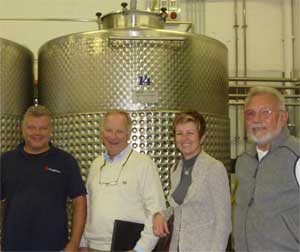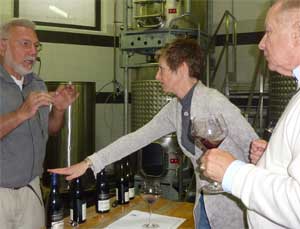Maison Anselmet: A Great Small Winery
© by Neil Duarte
Valle d'Aoste, the northwestern most province of Italy, lies just to the west of the city of Turin, home of the 2004 Winter Olympics. It is the smallest province in Italy with only 120,000 inhabitants in a valley that borders on France and Switzerland. Wine has been grown in this valley for over 2100 years. Some of the highest elevation vineyards in Europe are in this region and you might expect that most of the wine production would be white. However, depending on whose figures you believe, somewhere between 75 and 90 percent of the wine produced in Valle d'Aoste is red.
Though the phylloxera epidemic in the 19th century devastated the Valle d'Aoste vineyards, it did not result in total destruction of the vineyards. Today, there are 13 native vines, 12 of which are red and the white Prie. The red vines are: Petit Rouge, Vien de Nus, Fumin, Cornalin, Mayolet, Ner d'Ala, Vuillermin, Premetta, Crovassa, Bonda, Roussin and Roussin de Morgex. Additionally, international varieties include Chardonnay, Muller Thurgau, Pinot Blanc, Pinot Noir, Merlot and Syrah.
Annual wine production for Valle d'Aoste is a modest 1.7 million bottles/year. Six large cooperatives formed in 1970s and 24 small wineries grouped in the Viticulteures Encaveurs, provide the wines. Since the official language is both French and Italian, many of the labels, etc. are in French.
On a recent visit to Valle d'Aoste, I was introduced to one of the region's premier small wineries, Maison Anselmet, by my friend and one of the valley's leading restaurateurs, Elisabetta Allera. Maison Anselmet (www.vievini.it), located in the village of Fraz. Vereytaz, between the two towns of S. Pierre and Villeneuve, is owned and run by the father and son team of Renato and Georgio Anselmet. Like many mountain vineyards the vines are places on tiered and walled strips of land that provide a relatively flat surface. The day/night temperature differential, incline at which the sun hits the vines and the low amount of rain plus the all important terroir all contribute to the production of excellent grapes.
 | |
| Georgio Anselmet, Neil Duarte, Elisabetta Allera, and Renato Anselmet Photo: Terry Duarte. |
We began with some of the white wines produced by the winery. Maison Anselmet produces two Chardonnays, but we tasted only the higher level one. It was crisp, slightly fruity and pleasant to the taste. It is aged in oak barriques for 10 months before bottling. I am not normally a chardonnay fan, but this was a nice wine. Next we sampled a Muller Thurgau, the German grape also found in some parts of Northern Italy. This grape, a German cross of Riesling and Sylvaner, enjoys the altitude and retains its aromatic nose of fruit and flowers. Again, this was another very good white wine.
Now we moved to my favorites, the red wines. We began with their Pinot Noir, a 100 percent version. I think that this grape shows great versatility in location as this wine was an excellent version. It spends 8 to10 months in oak barriques before bottling and is very pleasant. Next we tried Torrette, a blend of 70 percent Petit Rouge and the remainder Fumin, Cornalin and Mayolet. This blend of several native Valle d'Aoste grapes, also aged in oak barriques for 10 months, was like many of this regions wines that have a shorter maturing season (the weather turns colder in mid-September). It was a very nice, medium bodied wine. Another native wine, Fumin, this one 100 percent pure, followed the Torrette. It also is aged 10 months in French oak barriques. Fumen is perhaps the most widely known red of the region and it also proved to be a smooth, slightly fruity and excellent medium red wine.
 | |
| Renato Anselmet describes Maison Anselmet's wines during the tasting Photo: Terry Duarte. |
Though I sampled only a small number of the wines of Valle d'Aoste at restaurants as well as Maison Anselmet, I came away impressed with the quality and variety of the region's wines. The only unfortunate thing is that because of the limited production of these wines, they are not widely available in the USA. However, if you see any wine from Valle d'Aoste on a wine list, don't hesitate to try it, especially if it is from Maison Anselmet. I think that you will be happy with your choice.
December 2009
